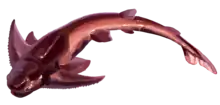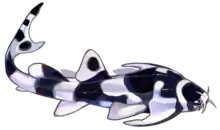| Rolfosteus Temporal range: Late Devonian: Frasnian, | |
|---|---|
 | |
| Scientific classification | |
| Domain: | Eukaryota |
| Kingdom: | Animalia |
| Phylum: | Chordata |
| Class: | †Placodermi |
| Order: | †Arthrodira |
| Suborder: | †Brachythoraci |
| Family: | †Camuropiscidae |
| Genus: | †Rolfosteus Dennis and Miles, 1979 |
| Species | |
| |
Rolfosteus is an extinct monospecific genus of arthrodire placoderm from the Early Frasnian stage of the Late Devonian period, found at the Gogo Formation of Western Australia.[1]
Description
Rolfosteus had a skull reaching 11.5 centimetres (4.5 in),[1] with tough plating on the front of its body. Like other arthrodires, such as Coccosteus and the giant Dunkleosteus, it had sharp, bony plates on its mouth which formed a turtle-like beak for cutting prey to pieces. Rolfosteus's most unusual feature was its highly elongated rostrum (snout), which may have been used to enhance its sense of smell as well as increase its hydrodynamic streamlining, making it well adapted to be a pelagic pursuit predator. Its fast jaw movement and jaw morphology allowed it to effectively capture prey and swallow them whole.[2]
Phylogeny
Rolfosteus is a member of the family Camuropiscidae under the superfamily Incisoscutoidea, which belongs to the clade Coccosteomorphi, one of the two major clades within Eubrachythoraci.[3][4] The cladogram below shows the phylogeny of Rolfosteus:[4]
| Eubrachythoraci |
| ||||||||||||||||||||||||||||||||||||||||||||||||||||||||||||||||||||||||||||||||||||||||||||||||||||||||||||||||||
References
- 1 2 Dennis, Kim; Miles, R. S. (December 1979). "Eubrachythoracid arthrodires with tubular rostral plates from Gogo, Western Australia". Zoological Journal of the Linnean Society. 67 (4): 297–328. doi:10.1111/j.1096-3642.1979.tb01118.x. ISSN 0024-4082.
- ↑ Trinajstic, Kate; Briggs, Derek E. G.; Long, John A. (23 November 2021). "The Gogo Formation Lagerstätte: a view of Australia's first great barrier reef". Journal of the Geological Society. 179 (1). doi:10.1144/jgs2021-105. ISSN 0016-7649.
- ↑ You-An Zhu; Min Zhu (2013). "A redescription of Kiangyousteus yohii (Arthrodira: Eubrachythoraci) from the Middle Devonian of China, with remarks on the systematics of the Eubrachythoraci". Zoological Journal of the Linnean Society. 169 (4): 798–819. doi:10.1111/zoj12089.
- 1 2 Zhu, You-An; Zhu, Min; Wang, Jun-Qing (1 April 2016). "Redescription of Yinostius major (Arthrodira: Heterostiidae) from the Lower Devonian of China, and the interrelationships of Brachythoraci". Zoological Journal of the Linnean Society. 176 (4): 806–834. doi:10.1111/zoj.12356. ISSN 0024-4082.
Further reading
- Long, John A. The Rise of Fishes: 500 Million Years of Evolution Baltimore: The Johns Hopkins University Press, 1996. ISBN 0-8018-5438-5







